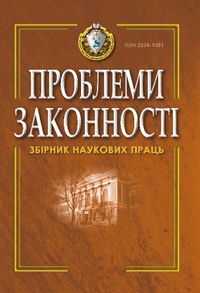Uncertain causation: two hunters dilemma
DOI:
https://doi.org/10.21564/2414-990x.149.196945Keywords:
causation, uncertain causation, tort, two hunters dilemmaAbstract
According to the general principles of tort law, in order to succeed a plaintiff must prove causal nexus between the damage he or she sustained and the actions of a particular defendant. However, in some factual situations this task appears to be impossible, and the question arises whether the plaintiff should be left uncompensated or rather the general rule on proof of causation has to be relaxed. In a groundbreaking case Summers v. Tice (the facts of which are also known as ‘two hunters dilemma’), the Supreme Court of California favored the latter option. The Court shifted the burden of proof and decided that under these exceptional circumstances it is for each of the defendants to absolve himself from liability by providing evidence that he could not had caused the damage. The conclusion of the Court does not cause any doubts. However scholars dispute over the exact explanation of that conclusion, because it is the explanation that is crucial for future similar cases.
The circumstances of the Summers case are thoroughly analyzed by many writers. Some suggest that even the number of defendants matters (supposing thus, that if there were three of them the court would not have reached the same conclusion). On the other hand, the character of their activity is underlined. The proponents of this point of view focus on the fact that the members of hunting party can coordinate their actions and it is this opportunity of coordination that justifies the burden shifting. The common denominator for numerous authors is spotlighting the fact that both hunters are at fault for causing the uncertainty, even though one of them might not be at fault for causing damage. However, in some other situation the uncertainty could have been caused without their fault. The author doubts if in the latter case the defendants should escape liability.
The author offers the following explanation of the two hunters dilemma. Whenever it has been proven that defendants acted negligently subjecting the plaintiff to a certain type of risk and it has been proven that one of them did actually caused plaintiff’s damage, neither of the defendants can absolve himself from liability merely relying on the fact that the damage may have been caused by the other defendant. Otherwise the vicious circle will arise.
References
Donska, L.D. (2006). Prychynnyi zviazok u tsyvilnomu pravi Ukrainy [Causal connection in civil law of Ukraine]. Extended abstract of candidate’s thesis. Odesa [in Ukrainian].
Bogdanov, D.E. (2012). Spravedlivost i voprosy ustanovleniya prichinno-sledstvennoy svyazi v sudebnoy praktike [Equity and finding causation in judicial practice]. Rossiyskaya yustitsiya – Russian justice, 12, 56–59 [in Russian].
Bogdanov, D. (2011). Prichinno-sledstvennaya svyaz kak usloviye deliktnoy otvetstvennosti [Causal connection as a precondition of tort liability]. Khozyaystvo i parvo – Economic and Law, 8, 106–110 [in Russian].
Bolotova, H.D. (2015). Do pytannia prychynnoho zviazku u hospodarskykh sporakh pro vidshkoduvannia zbytkiv [On the issue of causal connection in commercial disputes about damages]. Ekonomika ta pravo – Economics and Law, 2(41), 53–56 [in Ukrainian].
Vavzhenchuk, S., Dovhopol, V. (2011). Mezhi rozuminnia yurydychnoi pryrody prychynnoho zviazku v tsyvilnomu pravi [The boundaries of understanding the legal nature of causation in civil law]. Pidpryiemnytstvo, hospodarstvo i pravo – Entrepreneurship, economy and law, 2, 13–15 [in Ukrainian].
Hapalo, S.Yu. (2008). Prychynnyi zviazok mizh protypravnoiu povedinkoiu porushnyka hospodarskoho zoboviazannia ta zbytkamy yak pidstava hospodarsko-pravovoi vidpovidalnosti [Causal link between the wrongful conduct of the wrongdoer and damages as a basis of economic legal liability]. Universytetski naukovi zapysky – University Scientific Notes, 1, 132–137 [in Ukrainian].
Korzun, S.A. (2008). Prichinno-sledstvennaya svyaz – neobkhodimoye usloviye otvetstvennosti vladeltsev transportnykh sredstv: voprosy teorii i sudebnoy praktiki [A causal relationship is a prerequisite for the responsibility of vehicle owners: theory and court practice.]. Rossiyskiy sudia – Russian Judge, 4, 26–27 [in Russian].
Kulitska, S.V. (2016). Osoblyvosti prychynnoho zviazku u zoboviazanniakh po vidshkoduvanniu (kompensatsii) shkody, zapodiianoi vnaslidok protypravnoi diialnosti / bezdiialnosti orhaniv sudovoi vlady [Peculiarities of causal connection in obligations for compensation (compensation) for damage caused as a result of illegal activity / inaction of judicial authorities]. Visnyk Odeskoho natsionalnoho universytetu. Seriia: Pravoznavstvo – Bulletin of the Odessa National University. Series: Jurisprudence, vol. 21, issue 1 (28), 59–67 [in Ukrainian].
Pendiaha, A.L. (2011). Znachennia prychynnoho zviazku yak pidstavy tsyvilno-pravovoi vidpovidalnosti [The meaning of causation as the basis of civil liability]. Ekonomika, finansy, pravo – Economics, finance, law, 4, 34–36 [in Ukrainian].
Prymak, V. (2014). Prychynno-naslidkovyi zviazok yak umova vidshkoduvannia moralnoi shkody kriz pryzmu vymoh spravedlyvosti, rozumnosti y dobrosovisnosti [Causal connection as a precondition for the compensation of moral harm through the prism of the requirements equity, good faith and reasonablity]. Yurydychna Ukraina – Legal Ukraine, 1, 25–30 [in Ukrainian].
Shevtsov, S.G. (2012). Usmotreniye i prichinno-sledstvennyye svyazi v grazhdanskom prave [Discretion and cause-effect relationships in civil law.]. Sovremennoye pravo: nauchno-prakticheskiy zhurnal – Modern law: scientific journal, 3, 78–81 [in Ukrainian].
Hart, H.L.A., and Honoré (1959). Causation in the Law. Oxford: Oxford University Press.
Keeton, R. (1963). Legal Cause in the Law of Torts. Columbus, OH: Ohio State University Press.
Landes, William M. and Posner, R.A. (1983). Causation in Tort Law: An Economic Approach. The Journal of Legal Studies, 12(1), 109–134.
Calabresi, G. (1975). Concerning Cause and the Law of Torts: An Essay for HarryKalven,Jr., The University if Chicago Law Review, 43(69), 69–108.
Pound, R. (1957). Causation. Yale Law Journal, 67(1), 1–18.
Summers v. Tice, 33 Cal.2d 80, 199 P.2d 1 (1948). URL: https://law.justia.com/cases/california/supreme-court/2d/33/80.html
Mark A. Geistfeld. (2006). The Doctrinal Unity of Alternative Liability and Market-Share Liability. University of Pennsylvania Law Review, 155(2). 447–500.
Voyiakis, E. (2017). Causation and Opportunity in Tort. Oxford Journal of Legal Studies, 38(1), 26–47.
Cook v. Lewis. [1951] S.C.R. URL: https://scc-csc.lexum.com/scc-csc/scc-csc/en/item/2728/index.do.
Downloads
Published
How to Cite
Issue
Section
License
Copyright (c) 2020 Богдан Петрович Карнаух

This work is licensed under a Creative Commons Attribution 4.0 International License.










